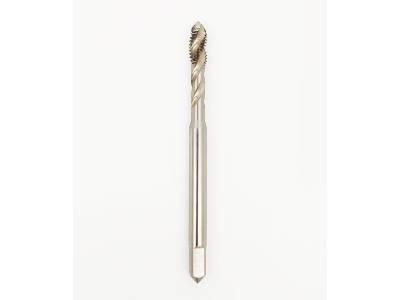As a common tool for Internal Thread Cutting, taps can be divided into spiral flute taps, edge inclination taps, straight flute taps and pipe thread taps according to their shapes. According to the use environment, they can be divided into hand taps and machine taps. Taps are also used in Mainstream processing tools used in tapping. So how to choose the tap? Today, the tap supplier will share with you a tap selection guide to help you choose the right tap.

Professional Tap
1. Straight flute taps: used for the processing of through holes and blind holes. Iron filings exist in the tap grooves, and the thread quality of the processed threads is not high. It is more commonly used for processing short chip materials such as gray cast iron.
2. Spiral flute tap: used for blind hole machining with a hole depth less than or equal to 3D, iron filings are discharged along the spiral flute, and the thread surface quality is high.
3. Spiral taps: usually only used for through holes, the ratio of length to diameter can reach 3D~3.5D, the iron filings are discharged downward, the cutting torque is small, and the surface quality of the processed thread is high. It is also called the edge tap or Tip tap.
1. Tool steel: It is mostly used for Hand Taps, which are not common anymore.
2. Cobalt-free high-speed steel: At present, it is widely used as tap material, such as M2, M3, etc., and the marking code is HSS.
3. Cobalt-containing high-speed steel: At present, it is widely used as tap material, such as M35, M42, etc., and the marking code is HSS-E.
4. Powder metallurgy high-speed steel: used as a high-performance tap material, the performance is greatly improved compared with the above two, and the naming methods of each manufacturer are also different.
5. Cemented carbide materials: Ultra-fine particles and good toughness grades are usually selected, which are mainly used to manufacture straight-groove taps for processing short-chip materials, such as gray cast iron, high silicon aluminum, etc.
The tap is highly dependent on the material, and the selection of good materials can further optimize the structural parameters of the tap, making it suitable for efficient and more demanding working conditions, and at the same time have a higher life. At present, major tap manufacturers have their own material factories or material formulas. At the same time, due to cobalt resources and price issues, new high-performance high-speed steels without cobalt have also come out.
a. Machine tool: It can be divided into vertical and horizontal processing methods. For tapping, vertical processing is better than horizontal processing. When horizontal processing is externally cooled, it is necessary to consider whether the cooling is sufficient.
b. Tapping shank: It is recommended to use Professional Tap shank for tapping. The machine is rigid and stable. Synchronous tapping shank is preferred. On the contrary, flexible tapping shank with axial/radial compensation should be used as much as possible. Except for small diameter taps, use square drive as much as possible.
c. Cooling conditions: For tapping, especially for extrusion taps, the requirement for coolant is lubrication>cooling; it can be adjusted according to the conditions of the machine tool in actual use.
a. The material and hardness of the workpiece: the hardness of the workpiece material should be uniform, and it is generally not recommended to use a tap to process workpieces exceeding HRC42.
b. Tapping bottom hole: bottom hole structure, choose a suitable drill bit; bottom hole size accuracy; bottom hole hole wall quality.
1. The type of thread to be processed, metric, imperial, American, etc.;
2. The type of threaded bottom hole, through hole or blind hole;
3. Material and hardness of the workpiece to be processed;
4. The depth of the complete thread of the workpiece and the depth of the bottom hole;
5. The required precision of the workpiece thread;
6. The shape standard of the tap.
Previous: Slab Gate Valve - An Overview
Copyright:@2020-2021
Comments Please sign in or sign up to post.
0
0 of 500 characters used